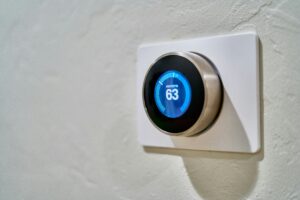Updated 3/10/22
It’s spring in Portland and Vancouver! Trees are flowering and you may be inclined to wear a lighter jacket outside or open your car window as you cruise along the highway.
While temperatures remain cool, warm weather is slowly on its way. Even small changes can affect the way you use energy in your home. Looking to save money on your electric bill as winter transitions to spring and still maintain a comfortable equilibrium? Consider these spring energy-saving tips:
Boost Thermostat Efficiency
The way you manage temperature change in your home can have a huge impact on your electricity usage. While you may still need to crank the heat on cold or windy days, warming temperatures allow for reduced heating.
If you have a thermostat in each room, consider which spaces you use most and heat only those areas. This allows you to save energy in less-used areas. After all, a big part of reducing your electricity usage is discovering the areas in your home where it’s being wasted.
Programmable thermostats can be especially helpful, allowing you to program your home to remain cool while you are out of the house and warm up when you return home and need the temperature adjusted. It can be useful to program your thermostat to increase in temperature before you get home, so you’re not tempted to turn it up even higher than you need in response to the chilly outdoors.
Spot Ventilate
Everyone knows what it’s like to walk into a condensated bathroom after someone has taken a shower or bath. Yuck. In order to reduce that muggy atmosphere quickly, many people open a window and allow the fog to clear. However, doing so can cool indoor temperatures and trigger your thermostat.
Instead, use a fan, vented to the outside of your home, to spot-ventilate areas like bathrooms and kitchens, reducing the need for compensatory energy use.
Prevent Air Leakage
Cracks and small openings in your home’s exterior can create a continual flow of undesirable air (i.e. hot or cold) into your home, increasing the need for heating or air conditioning. Although it may not seem like it, air leakage can consume a lot of energy. This leads to reduced energy efficiency and increased energy bills.
Sealing these leakage points can help prevent your home from cooling or heating without your control and also keep your thermostat from triggering unnecessarily. Caulk or weatherstripping methods are excellent options for sealing those pesky air leaks around your doors and windows.
Never used sealant before? There are several videos available on Youtube that can quickly and easily show you how to accomplish this task, including this one.
Choose Energy Efficient Appliances
In addition to conserving energy through DIY methods, you can also choose to switch to more efficient appliances. Before purchasing an air conditioner, check its energy efficiency ratio (EER). A score of ten or more is best and anything less than a six is unlikely to save energy.
One sure-fire way to determine if an appliance or electronic is energy efficient or not is to look for an ENERGY STAR® label.
Another easy spring energy-saving tip is to switch out your old incandescent bulbs for LED. This will save money because they use less energy and last longer.
Conduct Regular Appliance Maintenance
Purchasing energy-efficient appliances is only one step in reducing energy costs. Another important step is to conduct consistent maintenance on your appliances to keep them running smoothly.
For instance, cleaning or replacing your air conditioner’s air filters can help to improve energy efficiency.
Prairie Electric: Your trusted local electrician
Spring is a tricky time for homeowners. While the weather is warmer, there may still be cold days or weeks during which heating is required. In order to reduce your energy expenditure and enjoy the best possible weather, consider the above tips, and call Prairie Electric if you have any questions!


